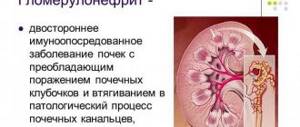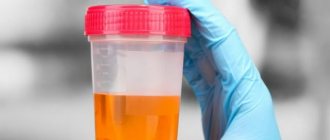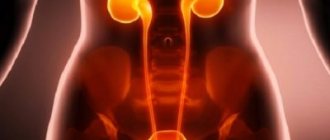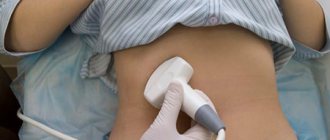The importance of the body's excretory system
Removing the end products of tissue metabolism from the body is a very important process, since these products are no longer capable of bringing benefits, but can have a toxic effect on humans.
Excretory organs include:
- leather;
- intestines;
- kidneys;
- lungs.
It is the kidneys that are responsible for urine formation and for removing unnecessary fluid rich in urea from the body.
Normal activity of the genitourinary system contributes to normal blood pressure, helps in stabilizing hormonal levels, as well as the process of homeostasis.
General characteristics of tubular reabsorption
Most of the fluid that enters the body is not excreted, but passes through the kidneys, or more precisely, through the tubules in which it is absorbed. And the vitamins and microelements necessary for the full functioning of the body enter the blood.
We are talking about substances such as glucose, sodium, water, proteins, etc. Unnecessary substances and breakdown products are eliminated from the body naturally along with urine, which is called secondary. The kidney tubules act as a special filter, which filters out those substances that are not needed by the body.
It is the efficiency of reabsorption that determines the quality of work of the human kidneys, consisting of nephrons, or renal units. Nephrons have their own special structure:
- the glomerular capsule, which is essentially a renal corpuscle, inside of which capillaries are located;
- convoluted tubule proximal;
- convoluted tubule distal;
- descending and ascending parts that make up the loop of Henle;
- a small or short section that connects to the collecting duct;
- The collecting duct located in the medulla is responsible for the drainage of secondary urine into the pelvis.
The total number of nephrons in one kidney can be about one million.
Types of reabsorption
Reabsorption in medicine is conventionally divided into certain types. Primary urine becomes secondary and ready to leave the body as a result of processes that occur in the kidney tubules, as well as in the collecting ducts.
In twenty-four hours, from one hundred and fifty to one hundred and seventy liters of primary urine, which is also called the filtrate, is formed in the human kidneys. But only one to one and a half liters of urine are excreted per day, since the processes of absorption of the rest of the liquid are carried out in the collecting ducts and in the renal tubules.
The final urine, which is subject to natural excretion from the body, is very different in composition from the primary urine. It completely lacks components such as glucose, some salts, and amino acids, but it usually contains a large amount of urea.
Depending on the location of the channel for the intake of nutrients for the body, tubular reabsorption is divided into two main types:
- proximal;
- distal.
Proximal reabsorption
In the proximal nephron, reabsorption of glucose, amino acids, most sodium ions, vitamins, microelements, and proteins usually occurs. In other segments of the nephron, electrolytes are reabsorbed.
The greatest energy expenditure comes from the body's reabsorption of chlorine and sodium, which is also the largest process in terms of volume. After filtration in the proximal tubule, the amount of primary urine decreases, and only one third of the fluid filtered in the glomeruli penetrates into the first section of the nephron.
Of the total concentration of the sodium element that entered the nephron during the process under consideration, no more than twenty-five percent is absorbed in the loop of Henle, and no more than nine percent is absorbed in the distal section. And less than one percent is concentrated in the collecting ducts and secondary urine.
Distal reabsorption
This reabsorption is characterized by the least transfer of ions in comparison with the proximal one, but it is this type of absorption of nutrients that affects the composition of secondary urine and its concentration.
Active transport of potassium, calcium ions, and phosphates occurs, the quality of urea improves, facilitating its absorption, as a result of which its penetration into the intercellular fluid is observed.
Facultative reabsorption, or selective, refers to physiologically regulated processes that occur in the distal segment of the nephron. This includes the reabsorption of water and certain types of ions.
Obligate reabsorption, or obligatory, occurs in the proximal nephron and is usually not subject to physiological control. These are the processes of absorption of water, sodium chloride, glucose and other components that occur in the proximal part of the nephron.
Varieties
There are several types of reabsorption, each of them depends on the area of the tubules in which the distribution of useful components occurs. There are two types of reabsorption:
- distal;
- proximal.
The latter is distinguished by the ability of these channels to transport and secrete protein, amino acids, water, vitamins, chlorine, sodium, vitamins, dextrose and trace elements from primary type urine. There are several aspects to this process:
- Water is released through a passive movement mechanism. The quality and speed of this process largely depends on the presence of alkali and hydrochloride in the purification products.
- Bicarbonate is transported through the implementation of a passive and active mechanism. The intensity of absorption largely depends on the part of the organ through which primary urine moves. Passage through the tubules occurs in a dynamic mode. Absorption through the membrane requires some time. Passive transportation is characterized by a decrease in urine volume, as well as an increase in bicarbonate concentration.
- The movement of dextrose and amino acids is carried out by epithelial tissue. These elements are localized in the alkaline zone of the apical membrane. These components are absorbed, and hydrochloride is simultaneously formed. The process is characterized by a decrease in bicarbonate concentration.
- When glucose is released, maximum connection with the moving cells occurs. If the glucose concentration is significant, then the load on transport cells increases. This process leads to the fact that glucose does not pass into the blood supply.
Processes occurring in the proximal tubule (active Na+,K+ transport is indicated in yellow)
The proximal mechanism is characterized by maximum protein and peptide uptake. In this case, the absorption of substances occurs in full force. Refining accounts for only 30% of the total nutrients. The distal variety changes the final composition of urine and also affects the concentration of organic compounds. At this stage, alkali is absorbed and the passive type of calcium, potassium, chloride and phosphates are transferred.
Mechanism of reabsorption processes
Reabsorption in the kidneys is a process in which maximum absorption of chemical elements and substances is observed that are most important for normal human life and the smooth functioning of all organs and systems.
Reabsorption and secretion of substances in the kidneys
There is a big difference between the ways in which organic elements are absorbed.
- Active reabsorption is the absorption of glucose, amino acids, sodium and magnesium. This is characterized by transport against an electrochemical concentration gradient. Active transport can be of two types - primary active and secondary active. In the first case, the energy obtained from the breakdown of adenosine triphosphoric acid is used to move potassium, sodium and hydrogen ions. In the second case, energy is not required to transport substances (amino acids, glucose, etc.).
- Passive absorption is the process of reabsorption of water, urea, and bicarbonate in the kidneys. Transportation is carried out along a concentration, electrochemical, osmotic gradient.
- Protein absorption is transported using pinocytosis.
The level of transportation of substances important for the body, as well as the speed of filtration, depends on what kind of life a person leads, how and what he eats, whether he has any chronic pathologies, etc.
Reabsorption in the tubules can occur in different ways, depending on the part of the nephron in which this process occurs. For example, water absorption can occur in any part of the nephron, but according to different patterns.
By osmotic mechanism, approximately forty to forty-five percent of water is absorbed in the proximal tubules. According to the rotary-countercurrent scheme, up to thirty percent of water is absorbed in the loop of Henle.
And in the distal section, at least twenty-five percent of water is absorbed, and it can be retained or excreted in secondary urine.
Sodium reabsorption in the kidneys is regulated by the hormone
Regulation of tubular reabsorption
carried out both nervously and, to a greater extent, humorally.
Nervous influences
are realized mainly by sympathetic conductors and mediators through beta-adrenergic receptors of the membranes of the cells of the proximal and distal tubules. Sympathetic effects manifest themselves in the form of activation of the processes of reabsorption of glucose, sodium ions, water and phosphate anions and are carried out through a system of secondary messengers (adenylate cyclase - cAMP). Neural regulation of blood circulation in the renal medulla increases or decreases the effectiveness of the vascular countercurrent system and urine concentration. The vascular effects of nervous regulation are also mediated through the intrarenal systems of humoral regulators - renin-angiotensin, kinin, prostaglandins, etc.
The main factor regulating water reabsorption in the distal nephron
is the hormone
vasopressin
, previously called antidiuretic hormone.
This hormone is formed in the supraoptic and paraventricular nuclei of the hypothalamus, and is transported along the axons of neurons to the neurohypophysis, from where it enters the blood. The effect of vasopressin on the permeability of the tubular epithelium is due to the presence of V2-type hormone receptors on the surface of the basolateral membrane of epithelial cells. The formation of the hormone-receptor complex entails, through the GS protein and guanyl nucleotide, the activation of adenylate cyclase and the formation of cAMP, activation of the synthesis and incorporation of type 2 aquaporins (“ water channels
”) into the apical membrane of collecting duct epithelial cells. Restructuring of the ultrastructures of the membrane and cytoplasm of the cell leads to the formation of intracellular specialized structures that transport large flows of water along an osmotic gradient from the apical to the basolateral membrane, preventing the transported water from mixing with the cytoplasm and preventing cell swelling. This transcellular transport of water through epithelial cells is realized by vasopressin in the collecting ducts. In addition, in the distal tubules, vasopressin causes the activation and release of hyaluronidases from cells, causing the breakdown of glycosaminoglycans of the main intercellular substance, thereby promoting intercellular passive transport of water along the osmotic gradient.
Table 14.1. Main humoral influences on urinary processes
Tubular reabsorption of water
is also regulated by other hormones (Table 14.1).
According to the mechanism of action, all hormones that regulate water reabsorption
are divided into six groups: •
increasing the permeability of the membranes
of the distal nephron to water (vasopressin, prolactin, human chorionic gonadotropin);
• changing the sensitivity of cellular receptors to vasopressin
(parathyrin, calcitonin, calcitriol, prostaglandins,
aldosterone
);
• changing the osmotic gradient of the interstitium of the renal medulla
and, accordingly, the passive osmotic transport of water (parathyrin, calcitriol, thyroid hormones, insulin, vasopressin);
• changing the active transport of sodium and chloride
, and due to this the passive transport of water (aldosterone, vasopressin, atriopeptide, progesterone, glucagon, calcitonin, prostaglandins);
• increasing the osmotic pressure of tubular urine
due to unreabsorbed osmotically active substances, such as glucose (contrinsular hormones);
• changing blood flow through the direct vessels of the medulla
and, thereby, accumulation or “washing out” of osmotically active substances from the interstitium (angiotensin-P, kinins, prostaglandins, parathyrin, vasopressin, atriopeptide).
source
Process regulation
Tubular reabsorption is regulated mainly in the distal parts of the nephron by the nervous and humoral systems. That is, the regulation of this process is carried out under the control of certain hormonal substances.
But no such control is observed over proximal reabsorption, which is why its second name is obligate. However, according to recent data, it has been found that its intensity may vary depending on certain effects of the humoral and nervous systems.
For example, when the nervous system is extremely excited, the absorption of sodium and glucose ions increases.
The intensity of reabsorption in the proximal tubules directly depends on the glomerular-tubular balance, the mechanisms of which have not been fully studied by science. But it has been established that maintaining this balance does not require the participation of nervous and humoral influences.
Distal reabsorption of ions and water, which is also called facultative, occurring in the distal tubules and collecting ducts, is regulated by the hormone aldosterone, vasopressin, and atrial natriuretic hormone. Aldosterone production occurs in the adrenal cortex in the glomerular zone. This hormone affects processes in the distal parts of the nephron and in the collecting ducts, causing an increase in the absorption of water and sodium ions.
Vasopressin is produced in the hypothalamus, and its release into the blood increases with a decrease in blood pressure, with a decrease in the amount of water in the body, with hyperosmia. Antidiuretic hormone promotes the retention of water in the body, increasing its reabsorption and reducing diuresis.
The formation of atrial natriuretic hormone occurs in the atria when they are stretched due to excess blood. This hormonal substance, on the contrary, reduces the absorption of water in the distal tubules, enhancing the process of urine formation and facilitating the removal of excess fluid from the body.
Tubular reabsorption in the kidneys: norm, mechanisms, physiology
Up to 80% of filtered sodium is reabsorbed in the proximal segments of the tubules, while about 8 - 10% is absorbed in the distal segments and collecting ducts.
In the proximal segment, sodium is absorbed with an equivalent amount of water, so the contents of the tubule remain isosmotic. The proximal regions are highly permeable to both sodium and water.
Through the apical membrane, sodium enters the cytoplasm passively along an electrochemical potential gradient.
Sodium then moves through the cytoplasm to the basal part of the cell, where sodium pumps (Mg-dependent Na-K-ATPase) are located.
Passive reabsorption of chlorine ions occurs in areas of cellular contacts, which are permeable not only to chlorine, but also to water. The permeability of intercellular spaces is not a strictly constant value; it can change under physiological and pathological conditions.
In the descending part of the loop of Henle, sodium and chlorine are practically not absorbed.
In the ascending part of the loop of Henle, a different mechanism for the absorption of sodium and chlorine operates. On the apical surface there is a system for transporting sodium, potassium and two chlorine ions into the cell. There are also Na-K pumps on the basal surface.
In the distal segment, the leading mechanism of salt reabsorption is the Na pump, which ensures sodium reabsorption against a high concentration gradient. About 10% of sodium is absorbed here. Reabsorption of chlorine occurs independently of sodium and passively.
In the collecting ducts, sodium transport is regulated by aldosterone. Sodium enters through the sodium channel, moves to the basement membrane and is transported into the extracellular fluid by Na-K-ATPase.
Aldosterone acts on the distal convoluted tubules and the initial sections of the collecting ducts.
Potassium transport
In the proximal segments, 90-95% of filtered potassium is absorbed. Some of the potassium is absorbed in the loop of Henle. The excretion of potassium in the urine depends on its secretion by the cells of the distal tubule and collecting ducts. When excess potassium enters the body, its reabsorption in the proximal tubules does not decrease, but secretion in the distal tubules increases sharply.
In all pathological processes accompanied by a decrease in filtration function, there is a significant increase in potassium secretion in the kidney tubules.
In the same cell of the distal tubule and collecting ducts, there are systems for potassium reabsorption and secretion. In case of potassium deficiency, they ensure maximum extraction of potassium from urine, and in case of excess, its secretion.
Secretion of potassium through cells into the lumen of the tubule is a passive process occurring along a concentration gradient, and reabsorption is active. Increased potassium secretion under the influence of aldosterone is associated not only with the effect of the latter on potassium permeability, but also with an increase in the flow of potassium into the cell due to increased work of the Na-K pump.
Another important factor in the regulation of potassium transport in the tubules is insulin, which reduces potassium excretion. The level of potassium excretion is greatly influenced by the state of acid-base balance. Alkalosis is accompanied by an increase in potassium excretion by the kidney, and acidosis leads to a decrease in kaliuresis.
Calcium transport
The kidneys and bones play a major role in maintaining stable calcium levels in the blood. Calcium intake per day is about 1 g. The intestines excrete 0.8 g/day, and the kidneys - 0.1-0.3 g/day.
In the glomeruli, ionized calcium is filtered and is in the form of low-molecular complexes.
50% of filtered calcium is reabsorbed in the proximal tubules, 20-25% in the ascending limb of the loop of Henle, 5-10 in the distal tubules, and 0.5-1.0% in the collecting ducts.
Calcium secretion does not occur in humans.
Calcium enters the cell along a concentration gradient and is concentrated in the endoplasmic reticulum and mitochondria. Calcium is removed from the cell in two ways: using the calcium pump (Ca-ATPase) and the Na/Ca exchanger.
The renal tubule cell must have a particularly effective system for stabilizing calcium levels, since it continuously flows through the apical membrane, and weakening of transport into the blood would disrupt not only the balance of calcium in the body, but would also lead to pathological changes in the nephron cell itself.
- Hormones that regulate calcium transport in the kidney:
- Parathyroid hormone
- Thyrocalcitonin
- Somatotropic hormone
Among the hormones that regulate calcium transport in the kidney, parathyroid hormone is the most important. It reduces calcium reabsorption in the proximal tubule, but at the same time reduces its excretion by the kidney due to stimulation of calcium absorption in the distal nephron and collecting ducts.
In contrast to parathyroid hormone, thyrocalcitonin causes an increase in calcium excretion by the kidney. The active form of vitamin D3 increases calcium reabsorption in the proximal tubule. Somatotropic hormone enhances calciuresis, which is why patients with acromegaly often develop urolithiasis.
Magnesium transport
A healthy adult excretes 60-120 mg of magnesium in urine per day. Up to 60% of filtered magnesium is reabsorbed in the proximal tubules.
Large amounts of magnesium are reabsorbed in the ascending limb of the loop of Henle. Magnesium reabsorption is an active process and is limited by the magnitude of maximum tubular transport.
Hypermagnesemia leads to increased excretion of magnesium by the kidney and may be accompanied by transient hypercalciuria.
With a normal level of glomerular filtration, the kidney quickly and effectively copes with an increase in the level of magnesium in the blood, preventing hypermagnesemia, so the clinician is more likely to encounter manifestations of hypomagnesemia. Magnesium, like calcium, is not secreted in the renal tubules.
The rate of magnesium excretion increases with an acute increase in the volume of extracellular fluid, with an increase in thyrocalcitonin and ADH. Parathyroid hormone reduces the release of magnesium. However, hyperparathyroidism is accompanied by hypomagnesemia. This is likely due to hypercalcemia, which increases the excretion of not only calcium but also magnesium in the kidneys.
Phosphorus transport
The kidneys play a key role in maintaining the constancy of phosphates in the internal fluids. In blood plasma, phosphates are presented in the form of free (about 80%) and protein-bound ions. About 400-800 mg of inorganic phosphorus is excreted through the kidneys per day.
60-70% of filtered phosphates are absorbed in the proximal tubules, 5-10% in the loop of Henle and 10-25% in the distal tubules and collecting ducts.
If the transport system of the proximal tubules is sharply reduced, then a greater capacity of the distal segment of the nephron begins to be used, which can prevent phosphaturia.
In the regulation of tubular transport of phosphates, the main role belongs to the parathyroid hormone, which inhibits reabsorption in the proximal segments of the nephron, vitamin D3, somatotropic hormone, which stimulate the reabsorption of phosphates.
Glucose transport
Glucose that passes through the glomerular filter is almost completely reabsorbed in the proximal segments of the tubules. Up to 150 mg of glucose can be released per day. Glucose reabsorption is carried out actively with the participation of enzymes, energy expenditure and oxygen consumption. Glucose passes through the membrane along with sodium against a high concentration gradient.
Glucose accumulates in the cell, phosphorylates it to glucose-6-phosphate, and passively transfers it into the peritubular fluid.
Complete reabsorption of glucose occurs only in cases where the number of carriers and the speed of their movement through the cell membrane ensure the transfer of all glucose molecules that enter the lumen of the proximal tubules from the renal corpuscles. The maximum amount of glucose that can be reabsorbed in the tubules when all transporters are fully loaded is normally 375 ± 80 in men and 303 ± 55 mg/min in women.
The level of glucose in the blood at which it appears in the urine is 8-10 mmol/l.
Protein transport
Normally, the protein filtered in the glomeruli (up to 17-20 g/day) is almost all reabsorbed in the proximal segments of the tubules and is found in small amounts in daily urine - from 10 to 100 mg. Tubular protein transport is an active process; proteolytic enzymes take part in it. Protein reabsorption occurs by pinocytosis in the proximal tubule segments.
Under the influence of proteolytic enzymes contained in lysosomes, the protein undergoes hydrolysis to form amino acids. Penetrating through the basement membrane, amino acids enter the peritubular extracellular fluid.
Amino acid transport
In the glomerular filtrate, the concentration of amino acids is the same as in the blood plasma - 2.5-3.5 mmol/l.
Normally, about 99% of amino acids are reabsorbed, and this process occurs mainly in the initial sections of the proximal convoluted tubule. The mechanism of amino acid reabsorption is similar to that described above for glucose.
There are a limited number of transporters, and when they all combine with the corresponding amino acids, the excess of the latter remains in the tubular fluid and is excreted in the urine.
Normally, urine contains only traces of amino acids.
- The causes of aminoaciduria are:
- an increase in the concentration of amino acids in plasma with increased intake into the body and with disruption of their metabolism, which leads to overload of the transport system of the kidney tubules and aminoaciduria
- defect in the transporter responsible for amino acid reabsorption
- a defect in the apical membrane of tubule cells, which leads to an increase in the permeability of the brush border and the zone of intercellular contacts. As a result, there is a reverse flow of amino acids into the tubule
- metabolic disorder of proximal tubule cells
This may be useful for you:
Source: //infolibrum.ru/diseases/renal_diseases/kanaltsevaya-reabsorbtsiya.html
What violations can there be?
Kidney diseases can be caused by various reasons, among which pathological changes in reabsorption are not the least important. If water absorption is impaired, polyuria, or a pathological increase in urine formation, may develop, as well as oliguria, in which the daily urine content is less than one liter.
Impaired absorption of glucose leads to glucosuria, in which this substance is not reabsorbed at all and is completely excreted from the body along with urine.
A very dangerous condition is acute renal failure, when kidney function is impaired and organs stop functioning normally.











